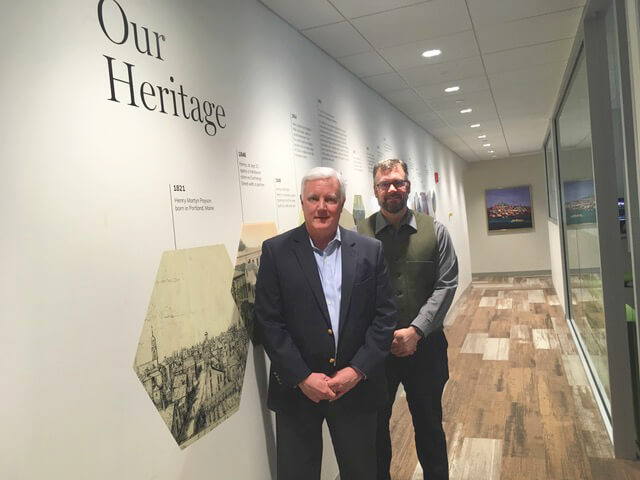On Friday, March 6, 2009, Peter Robbins, CEO of H.M. Payson received a frantic phone call from an institution in Midcoast Maine. “You’ve got to come up here right away…We have a large benefactor who wants us to sell everything.” It was an historic day. The Dow Jones Industrial Average was on its fourth straight week of losses, the S&P 500 was below 700 for the first time in 13 years – all of this following the September collapse of Lehman Brothers.
Everyone was panicking.
Robbins, who runs Maine longest running investment firm, agreed to visit the institution on his way to Sugarloaf, and he took a colleague from his office along for the ride. “We arrived to a room full of terrified people that Friday, and we weren’t even sure why we were there since the institution wasn’t even a client at the time.” It was clear that they needed advice, and quickly. So, Robbins listened to their challenges and then walked them through the math. “I explained that either the world was going to spin off its axis, or people were going to make a lot of money owning stocks.” Then, he left the meeting and continued on to Sugarloaf.
The following week, the market began its soaring rebound, and within a year, the DOW had regained more than 60 percent of its losses.
The story illustrates the enormous value and the critical role that an investment advisor plays – in good times and bad. It also illustrates why Piper Shores insisted on seeking the most highly qualified financial advisor to guide the institution on its investment strategy.
“Piper Shores has the obligation to manage its assets responsibly,” says, Jim Adamowicz, CEO of Piper Shores, and for this reason, the investment committee of the board initiated a formal search for a new investment firm in 2015. The six-month due diligence process during which nine firms were evaluated resulted in a promising new partnership with H.M. Payson that is already bearing positive results. In 2017, Piper Shores investment portfolio returned over 16%, while still maintaining a conservative balance of stocks, bonds, and short-term financial instruments needed for entrance fee refunds over the course of the year.
H.M. Payson is a highly regarded investment advisor and trust company that was established in 1854 in Portland, Maine. Today the firm manages $3.4 billion in assets for 1,200 clients with a staff of 40 highly trained professionals. Most of H.M. Payson’s clients are right here in Maine, followed by Florida, Massachusetts, New York, New Hampshire, and some international clients. The firm is known for serving multiple generations of families (children, grandchildren, and great grandchildren), and for its very low turnover of clients and staff.

Sitting down with H.M. Payson CEO Peter Robbins and Managing Director of Research David R. Hines, it quickly becomes obvious why and how the firm differentiates itself from the pack.
“We take a highly customized approach that requires a huge amount of preparation – all of this before making an investment,” explains Hines. An elite team of professionals is assigned to every client, and they sit down together for hours, unravelling the nuances and the specific needs of each organization or individual. In the case of Piper Shores, an H.M. Payson team started with an intensive internal analysis followed by four separate visits to Piper Shores to meet with the CEO, CFO, and the investment committee. They made it their singular purpose to understand the unique aspects of Piper Shores policy needs.
“We don’t just plug into an asset allocation computer model,” explains Hines. “Everything we do is built from scratch.” Hines notes that Piper Shores investment strategy required high-level policy considerations that were complicated by the fact that they are a life-care community that reports to insurance regulators.
“We came up with an asset liability mix that consists of 70 percent equity and 30 percent bonds – which includes a volatility risk and stay-ahead-of-inflation growth risk. And while the investment policy did not shift dramatically from previous approaches, the team took the time to prove out any assumptions. “The big change was to introduce some passive funds instead of just stocks. And on the active side, we made some substantial changes,” says Hines.
Both Robbins and Hines commented on the exceptional quality of the Piper Shores community and the depth of its investment committee. “I love working with investment committees because it’s a role where we can easily add value,” explains Robbins. For example, for many institutional clients, H.M. Payson is the institutional memory of the organization. “You know, boards and investment committees turn over, yet we do not,” he said.
Another invaluable advantage of having an investment committee is related to the pitfalls associated with governing exclusively by committee. “Behavioral theorists have spent a lot of time studying committees and when you wrap the mantel of ‘Trustee’ around someone’s shoulders and put them into a committee of other trustees, they tend to compound all of the biases that we make as individuals. That’s another way of saying that they do the wrong thing at the wrong time.”
H.M. Payson’s job, says Robbins, is to provide psychological governance, meaning that during periods of market extreme – either down or up – committees often feel that action is required, but more often, they should just stay the course.
In the heat of the moment, many institutions and individuals fall prey to their fears. “The great challenge is to stay the course,” says Hines.
And that’s why he has a framed ski ticket hanging beside his desk:

Sugarloaf
Day-Ticket
March 7, 2009
Hines and Robbins both went skiing that day, while the rest of the world panicked. The following Monday, March 9, 2009, the S&P 500 index bottomed at 666 and has since returned 260% or 17.67% per year with dividends reinvested through the end of March 2018.